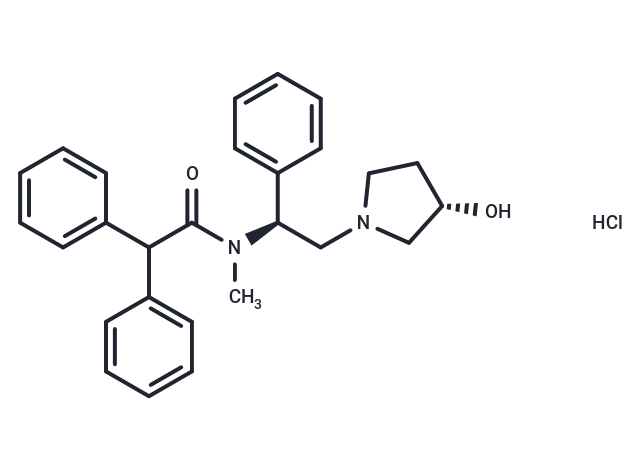Shopping Cart
- Remove All
 Your shopping cart is currently empty
Your shopping cart is currently empty

Asimadoline hydrochloride (EMD-61753 hydrochloride) is a κ-opioid receptor agonist potentially for the treatment of pruritus. Asimadoline hydrochloride has also been shown to be used in the treatment of irritable bowel syndrome.

| Pack Size | Price | Availability | Quantity |
|---|---|---|---|
| 1 mg | $30 | In Stock | |
| 5 mg | $67 | In Stock | |
| 10 mg | $113 | In Stock | |
| 25 mg | $239 | In Stock | |
| 50 mg | $355 | In Stock | |
| 100 mg | $526 | In Stock | |
| 500 mg | $1,130 | In Stock | |
| 1 mL x 10 mM (in DMSO) | $74 | In Stock |
| Description | Asimadoline hydrochloride (EMD-61753 hydrochloride) is a κ-opioid receptor agonist potentially for the treatment of pruritus. Asimadoline hydrochloride has also been shown to be used in the treatment of irritable bowel syndrome. |
| Targets&IC50 | κ opioid (Guinea pig):5.6 nM (EC50), κ opioid (human recombinant):1.2 nM (EC50) |
| In vitro | The IC50 for Asimadoline binding to μ-opioid receptors is 3 μM and to δ-opioid receptors is 0.7 μM. At high concentrations, Asimadoline demonstrates spasmolytic action against 400 μM barium chloride in the rat duodenum (IC50: 4.2 μM), suggesting that Asimadoline may block the direct stimulant effects of barium on smooth muscle through mechanisms that are not identified[1]. |
| In vivo | The metabolism of Asimadoline is rapid and appears similar in animals and man. The absorption rate following oral administration is 80% in rats and >90% in dogs and monkeys. Asimadoline has peripheral anti-inflammatory actions that are partly mediated through an increase in joint fluid substance P levels[1]. Treatment with Asimadoline (5 mg/kg/day i.p.) produces marked (and sustained) attenuation of the disease with all three-time regimes[2]. |
| Animal Research | Asimadoline (5 mg/kg/day, n=10 per group) or vehicle (2 mL/kg/day, n=10) is administered to DA rats by i.p. injection twice daily (i) during the primary inflammatory phase (days 1–3); (ii) once the disease is established (days 13–21); or (iii) throughout the entire time course (days 1-21). Non-arthritic control animals receive Asimadoline (5 mg/kg/day, n=5) or vehicle (2 mL/kg/day, n=5) by i.p. injection twice daily. In all cases, disease parameters are assessed. In this experiment, the SP content of joint tissue is assessed only after the rats are killed (day 21)[2]. |
| Alias | EMD-61753 hydrochloride |
| Molecular Weight | 451.01 |
| Formula | C27H31ClN2O2 |
| Cas No. | 185951-07-9 |
| Smiles | C(C(N([C@H](CN1CC[C@H](O)C1)C2=CC=CC=C2)C)=O)(C3=CC=CC=C3)C4=CC=CC=C4.Cl |
| Relative Density. | no data available |
| Storage | Powder: -20°C for 3 years | In solvent: -80°C for 1 year | Shipping with blue ice. | |||||||||||||||||||||||||||||||||||
| Solubility Information | DMSO: 60 mg/mL (133.03 mM), Heating is recommended. | |||||||||||||||||||||||||||||||||||
Solution Preparation Table | ||||||||||||||||||||||||||||||||||||
DMSO
| ||||||||||||||||||||||||||||||||||||

Copyright © 2015-2025 TargetMol Chemicals Inc. All Rights Reserved.